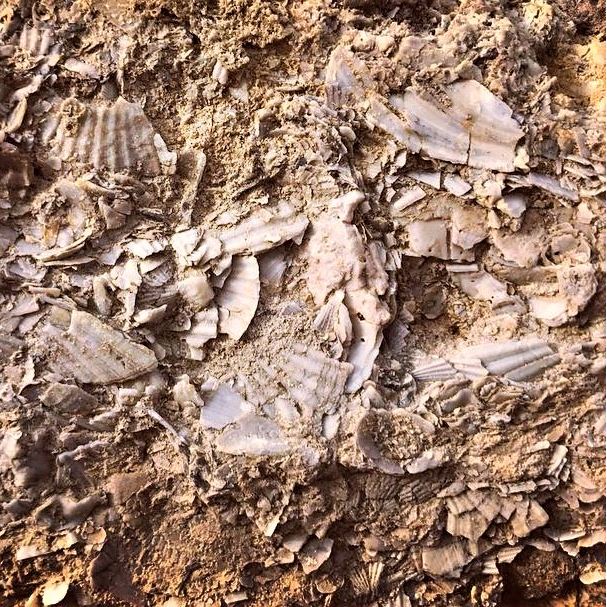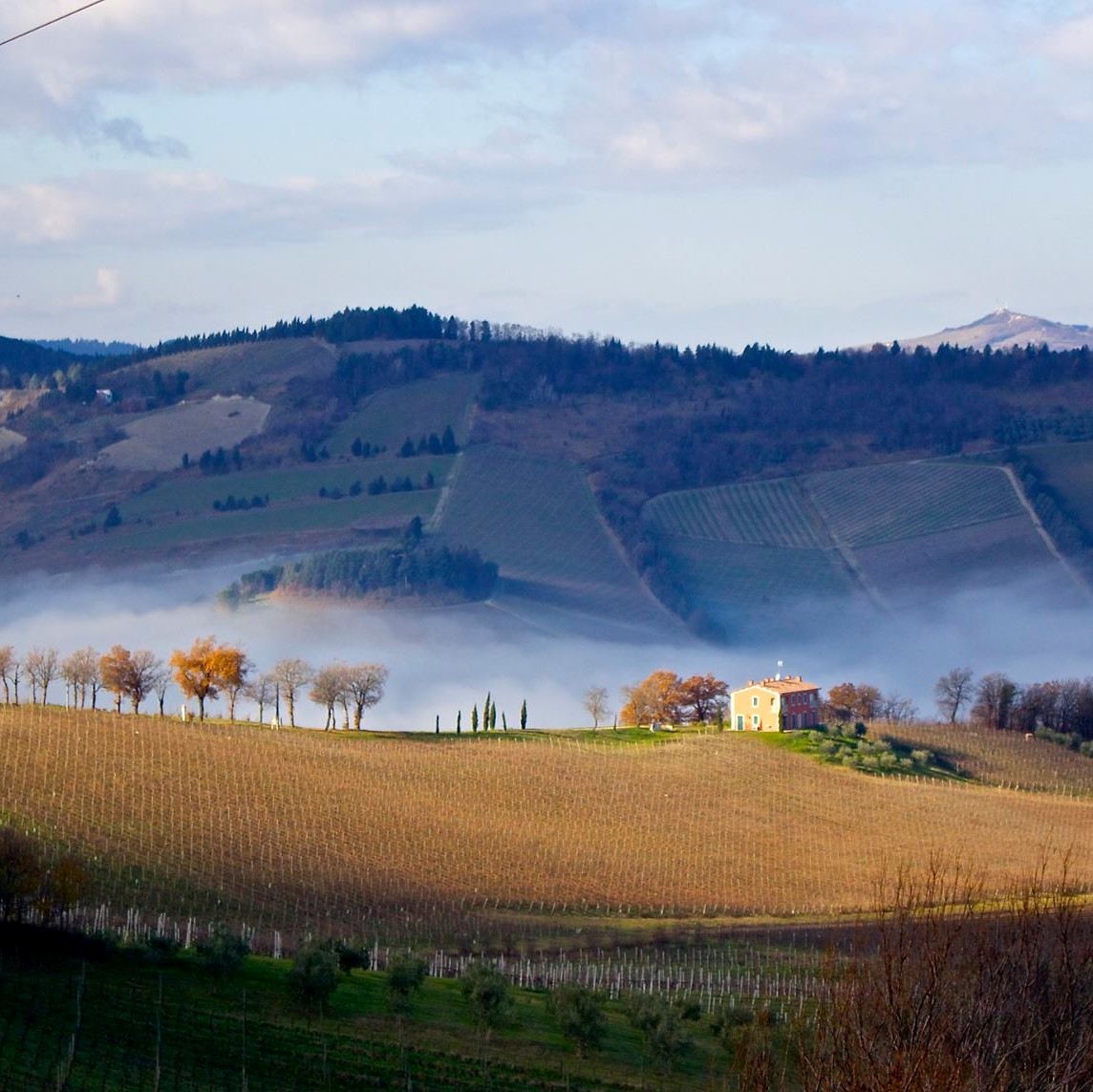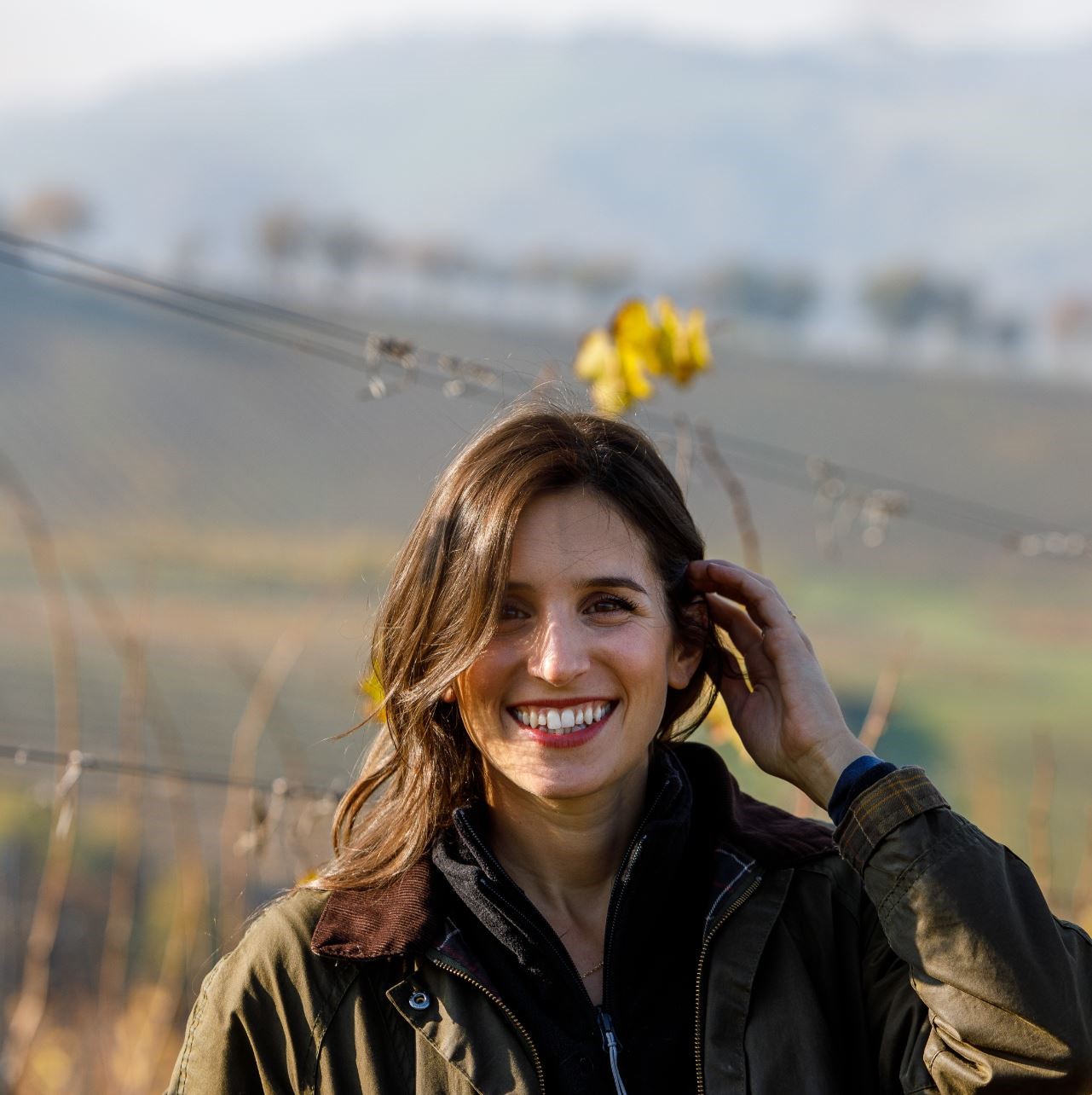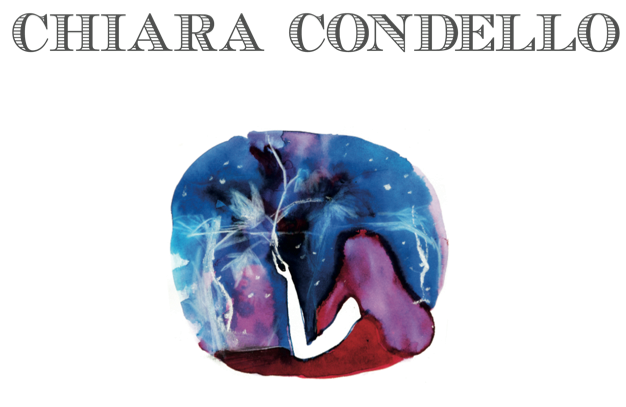Grower: CHIARA CONDELLO
Date of interview: May 24th, 2021
Reading time: 6 minutes
It's no stretch to say that Chiara Condello is recognized as one of Italy's most exciting and thoughtful young winemakers - farming old vines in Predappio, a small appellation in the foothills of the Apennines (Romagna) that many people recognize as the ancestral home of Sangiovese.
Despite formal winemaking regulations dating back to 1383, demonstrating the historical pedigree of Predappio, Chiara is the only grower utilizing what she refers to as the “ancient method” of production. Through these time tested methods, Chiara fosters long lived wines of beautiful harmony and energy that stand equally alongside the brightest wines of Chianti Classico and Brunello di Montalcino.
A recent sit down with Vinous Live (among others) underscores the important work that Chiara is doing to shine a light on Predappio and on the excellent quality that the land is capable of. In this interview, she discusses deviating from the well worn path to found her own winery, the influence from her garagiste grandfather, the ancient method of wine production in Predappio, and her goal to help re-elevate Sangiovese di Predappio to the global stage.
This interview was slightly shortened for brevity, although the conversational language used used by Chiara was preserved as much as possible.
Vine Farmer: Could you start by telling us a little bit about Predappio and Romagna?
Chiara: Yes, Emilia and Romagna are very different places despite the link from the regional name (Emilia-Romagna). Bologna is more or less in the middle of the two. Emilia is more an internal part of the region while Romagna is more the coastal part that touches the Adriatic Sea. In Emilia, they produce totally different wine (Lambrusco), and have an independent culture, cuisine, and dialect. In Romagna, the indigenous varieties for winemaking are Sangiovese and Albana.
In Predappio, we are in the hills of the Apennines. First, it is quite windy – we have a strong circulation of air which gives us less disease pressure than other areas, such as Tuscany. We also have strong temperature fluctuations - the temperature difference between night and day is quite large. This is particularly evident in the Summer. The other thing to consider is that we are on the north side of the Apennines, while Tuscany, for instance, is on the South side. So, the general climate there is warmer, and our climate is colder. We have quite a lot of frost and snow in Winter.
The other unique aspect about Predappio is the soil. There is a lower part of the appellation with more sand and an upper part characterized by the soil of the mountains. Where I have the vineyards is more or less in the middle of the appellation - I have a general calcareous clay soil, but the most important thing to note is a specific kind of rock called Spungone, which means sponge, because it is like a big sponge. This rock originates 3 million years ago when the Adriatic Sea was here in Predappio. When the sea moved away, it left fossils, coral, and sand in the soil. From this, Spungone was born.
Vine Farmer: Could you tell us a little more about the history of winemaking in Predappio?
Chiara: In Predappio, the life of the village itself was always linked to wine production, starting from when the village was founded in the Roman era. The first thing we can observe about winemaking in Predappio is a medieval cellar in the center of the village that was shared by everyone who did not have their own cellar.
The first written rules and regulations for winemaking were documented in 1383. The rules dictated very specific details, even for things such as the proper way to prune the vines. Harvest couldn’t happen until a council deemed the grapes ready to be picked. And all of the vineyards were specific "clos" (walled vineyards), very close together. It’s amazing to me to think of these specific rules from 1383 – it illustrates just how important winemaking was to this little village and how it was known to be an appellation of true distinction.
And then, of course, these traditions have been passed from generation to generation. In Predappio Alta, we have La Festa de la Vendemmia - a party where everyone from the village attends every Fall to celebrate the harvest. So, this sense of being linked to the vineyards is very, very strong.
Vine Farmer: Could you tell us a little bit about Sangiovese di Predappio?
Chiara: Sangiovese di Predappio is a clone native to Predappio. It is a Sangiovese that has slightly smaller berries than, say, Sangiovese Grosso from Montalcino – the skin to juice proportion is a little bit higher in our Sangiovese. The grapes also have more space between them than other clones of Sangiovese. The wine tends to have a very vivid, brilliant color. Sangiovese from Predappio also is quite fruity in youth and also with age. Of course, there are many non-fruit aromas, but the fruitiness tends to remain intense. There is also quite a lot of tannin with Sangiovese di Predappio, but the tannins are always very small and fine.
The other aspect of our Sangiovese is that it has a very long life - the potential for aging is significant. One of my favorite wines was a Sangivoese di Predappio from 1930 that I had a couple of years ago. It was a very great experience because we were able to see how our wine evolves in a beautiful way.
Vine Farmer: It’s interesting that you noted fine tannins – with thicker skin, I would have expected a propensity for rougher, more powerful tannins. What causes the tannins to be so fine despite the skin thickness?
Chiara: I think everything is ultimately linked to the composition of our soils. The thickness is one aspect, but the quality of the soil has a greater impact on that quality, I think. Thicker skins are also what allows us to have a long maceration time and to work in a certain way in the cellar.
Vine Farmer: We commonly find in Italy that appellations with strong historical winemaking reputations seem to have been forgotten in modern times. Do you have a sense as to why Predappio and Sangiovese di Predappio is not as well known, as say, Sangiovese Grosso from Montalcino?
Chiara: For one, the appellation of Predappio was not officially back to us to be used on labels until 2011. Prior to 2011, wine from Predappio was grouped together under the Sangiovese di Romagna appellation.
The other thing is that Predappio is close to the Adriatic coast. If we go back to the 1950s, let’s say, after the Second World War, most people left Predappio for the coast, because it was the moment after the war of great economic growth, the economic boom. Many people opened restaurants and hotels on the ocean. It was more profitable and easier to establish a business on the coast than it was to continue viticulture up in the hills – especially with the appellation not being recognized.
Even so, some connoisseurs still understood the quality of Predappio because of our history. However, for most people, it all needed to be re-explained and rebuilt.
Vine Farmer: When did you start your winery and this project? What were the influences in your life that helped to lead you here?
Chiara: Well, I had many different influences. I think the first one was linked to my childhood, because I grew up with my grandfather, producing wine. Until I was fourteen, I was living with my Grandparents. My Grandfather had a vineyard. He was a farmer - an Italian Farmer - so he had a vineyard, but he also had fruit trees and other crops. Growing up with him, I was used to the life in the vineyard and also a little bit in the cellar. My Grandfather was a really a garagiste in terms of winemaking and production. The vinification was in the house, in a very small and not even proper cellar. That was really the beginning of my approach to viticulture and cellar work.
When I was older, I ended up studying at university, and in the meantime my Father started his own winery. When I graduated, I was supposed to go and work for a consultancy, but I had a couple of months off, and I decided to come back to my family winery - my Father’s winery.
I started working in the vineyards and I began to approach winemaking as an adult. And so, little by little, I realized it was what I wanted to do. I kept postponing the job I was supposed to start doing, and little by little, I realized I was not postponing – I wanted to stay in Predappio to produce wine.
In 2015, I had the chance to purchase for myself some old vineyards in Predappio, from neighbors. From that point, I started my own little winery.
Vine Farmer: You have a much higher profile and have received more recognition than any other winemaker in Predappio. Is there anything that is unique about your approach? What is your approach?
Chiara: I think that I am different because I “go back” - I have decided to retake the old, ancient approach, to the vineyards and the cellar. As I mentioned, I grew up with my grandfather. I grew up in a cellar that was operated in a very traditional way; maybe even too much. It had only a soil floor. Some things have changed with my cellar, but I wanted to keep the same approach.
The way to vinify is exactly the same. For instance, whole cluster fermentation – I don’t believe anyone else is doing that. My first attention is always to the fruit; to respect it. Movements happen by gravity, and I do not do any pigeage (punch downs) of the fruit. The fruit enters the fermentation vessel whole and with stems, un-pressed. This is very important. The thing that changes depending on the vintage is the percentage of whole cluster.
The fermentation takes place carried out by indigenous yeast – I don’t want to interfere with it. The idea is to also respect the characteristic of the vintage. So, if we have a warm vintage, I expect my fermentation to happen a little bit quicker and to start earlier. If it’s cold, I can expect the fermentation to be a little bit longer. And I like that – I like to be able to bring all that into the final wine. This is the general approach.
For fermentation, I use open topped conical vats. They are called “tino”. A funny thing is that in Romagna the name is masculine, whereas in Piemonte, the same vats are called “tina”. I also do some fermentation in little tanks or tonneau. For aging, I generally use big, old botti – 3,500 liters. However, I do use a little concrete as well.
Sangiovese is a very beautiful variety because it is such a transparent variety. It gives you back the characteristic of the soil and of the vintage. Time is needed to arrive at a balance. When it is just vinified, it is very beautiful, and then it closes for the winter and opens back up the following summer. My idea is just to wait for everything, patiently.
I think it’s a beautiful approach – not pushing things. Just behind the scenes helping the wine, if needed, from behind. You let the wine express and simply try to follow.
Vine Farmer: What is your farming philosophy?
Chiara: The focus is to work in a respectful way for the entire environment, not just for a single plant. I only work in an organic way. We make some preparations at the beginning of the season with garlic and spices to have protection from some insects - so very natural. The infusion of cover crop is used as well. I try to assess the specific need of every vineyard parcel because they all have different altitudes and soils.
Vine Farmer: What are the primary distinctions between your different vineyards?
Chiara: First, people who come to visit me see that my vineyards are not surrounded by other vineyards – they are surrounded by forest. So here there is a huge biodiversity. If you go into the vineyards and turn to one side, you see the mountains and all the related vegetation and climate. Looking to the flatter land by the sea on the other side, everything is totally different. My vineyards are directly in between and take influences from both aspects. This place is a union of different plants and animals, creating a unique biodiversity. We even have wolves here... It is really a very particular place.
The main differences in my vineyards can be seen between Le Lucciole and the others. Le Lucciole is planted on a very rocky soil, very rich in Spungone. It is a sort of a slope. One the upper part, the rock is at the surface, so it is a very poor soil. In the lowest part of the vineyard, the rock goes a little bit deeper. However, the rock is the most important defining characteristic of that vineyard.
The other three vineyards have unique soils, but the common aspect is that they are all clay based. One is planted on very deep clay at 350 meters. Another is more red soil – iron mixed in with the clay. The third is the lowest and closest to the village, at about 150 meters. That is planted on calcareous clay. The Spungone is in all 3 vineyards, but the concentration is the highest in Le Lucciole.
Vine Farmer: What is the origin of the name “Le Lucciole”?
Chiara: The name is from many years ago when I was not yet making wine. I was with friends in Montalcino, tasting Brunello. In the wines I loved, I could sense some impression of fresh golden fiano grass on a summer night. In all these wines I loved, I had this perception of this uniquely summer night sensation. I told my friends that if I made a Sangiovese that I loved, I would call it "Le Lucciole", for the summer.
And so, years later, when I decided to give a name to this wine, I remembered that. And then the other aspect is that "Le Lucciole" means “fireflies”. In Summer 2015, when I began, the parcel of Le Lucciole was totally full of fireflies. It has all the woods surrounding it, so the fireflies find a perfect home there.
Vine Farmer: Reflecting on what you’ve accomplished so far, what is important about the work that you do?
Chiara: First, as I mentioned, Predappio is a historical place for wine production. It is a very important thing, on one side, to continue these winemaking traditions that are linked both to my family and to Predappio. Apart from that, I think that the other important thing – which is linked, actually – is to continue growing the native kind of Sangiovese, Sangiovese di Predappio.
Of course, in my way of working, I try to be respectful in many different ways – respectful of the native grape, respectful of the environment here. And because of that, my idea is to preserve this place.
Vine Farmer: What do you hope your reputation evolves into? What would make you happy?
Chiara: I hope that the world can recognize the uniqueness of Predappio and our Sangiovese. If my bottles can help with this, that would make me very happy. It’s about my land and all the stories that have come together before me, and the stories that will happen after me. I hope to be a good guardian for this period of time.



